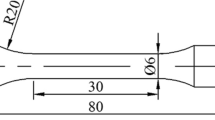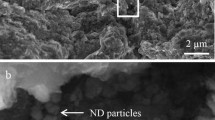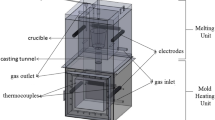Abstract
Zinc-nanodiamond (ND) composite is proposed as a novel biodegradable implant material due to its desirable corrosion, mechanical, and biocompatible properties. In this research, the microstructure, corrosion behavior, and mechanical properties of Zn-ND composites were investigated for the first time as a potential implant material in biomedical applications. Powder metallurgy manufacturing processes were used and different sintering conditions were studied. Grain size increased with increasing sintering temperature and longer sintering time. Corrosion resistance was improved 61.0, 65.9, and 70.7 % for 1, 2.5, and 5 % ND compared with pure Zn. Compression and hardness tests were performed to determine the mechanical properties. In the compression tests, Zn-1ND showed the highest Young’s modulus, with 10.95 and 27.32 % more than pure Zn and Zn-5ND. Pure Zn had the highest compressive strength, 11.8 and 29.5 % higher than Zn-1ND and Zn-2.5ND. Zn-1ND and Zn-2.5ND are 55.2 and 68.9 % lower in hardness compared with pure Zn (HV = 27). Compression-molded zinc with low concentrations of nanodiamond offers a promising combination of strength and low corrosion rate, and with strength approaching cortical bone and higher than most biological tissues.








Similar content being viewed by others
References
Zhang Y, Zhang G, Wei M (2009) Controlling the biodegradation rate of magnesium using biomimetic apatite coating. J Biomed Mater Res B Appl Biomater 89B(2):408–414
Witte F et al (2005) In vivo corrosion of four magnesium alloys and the associated bone response. Biomaterials 26(17):3557–3563
Vojtěch D et al (2011) Mechanical and corrosion properties of newly developed biodegradable Zn-based alloys for bone fixation. Acta Biomater 7(9):3515–3522
Tapiero H, Tew KD (2003) Trace elements in human physiology and pathology: zinc and metallothioneins. Biomed Pharmacother 57(9):399–411
Blencowe DK, Morby AP (2003) Zn(II) metabolism in prokaryotes. FEMS Microbiol Rev 27(2–3):291–311
Dardenne M (2002) Zinc and immune function. Eur J Clin Nutr 56:S20–S23
Samman S (2007) Zinc. Nutr Diet 64:S131–S134
Fosmire GJ (1990) Zinc toxicity. Am J Clin Nutr 51(2):225–227
Bowen PK, Drelich J, Goldman J (2013) Zinc exhibits ideal physiological corrosion behavior for bioabsorbable stents. Adv Mater 25(18):2577–2582
Bianco A, Kostarelos K, Prato M (2005) Applications of carbon nanotubes in drug delivery. Curr Opin Chem Biol 9(6):674–679
Bianco A (2004) Carbon nanotubes for the delivery of therapeutic molecules. Expert Opin Drug Deliv 1(1):57–65
Kam NWS, Dai H (2005) Carbon nanotubes as intracellular protein transporters: generality and biological functionality. J Am Chem Soc 127(16):6021–6026
Kam NWS et al (2005) Carbon nanotubes as multifunctional biological transporters and near-infrared agents for selective cancer cell destruction. Proc Natl Acad Sci USA 102(33):11600–11605
Schrand AM, Hens SAC, Shenderova OA (2009) Nanodiamond particles: properties and perspectives for bioapplications. Crit Rev Solid State Mater Sci 34(1–2):18–74
Schrand AM et al (2006) Are diamond nanoparticles cytotoxic? J Phys Chem B 111(1):2–7
Liu K-K et al (2007) Biocompatible and detectable carboxylated nanodiamond on human cell. Nanotechnology 18:32
Yuan Y et al (2010) Pulmonary toxicity and translocation of nanodiamonds in mice. Diam Relat Mater 19(4):291–299
Dewidar M, Yoon H-C, Lim J (2006) Mechanical properties of metals for biomedical applications using powder metallurgy process: a review. Met Mater Int 12(3):193–206
Clark GCF, Williams DF (1982) The effects of proteins on metallic corrosion. J Biomed Mater Res 16(2):125–134
Song G (2007) Control of biodegradation of biocompatable magnesium alloys. Corros Sci 49(4):1696–1701
Kokubo T, Takadama H (2006) How useful is SBF in predicting in vivo bone bioactivity? Biomaterials 27(15):2907–2915
Cai S et al (2012) Effects of Zn on microstructure, mechanical properties and corrosion behavior of Mg–Zn alloys. Mater Sci Eng C 32(8):2570–2577
Wang W et al (2002) Influence of hot pressing sintering temperature and time on microstructure and mechanical properties of TiB2 ceramics. J Eur Ceram Soc 22(7):1045–1049
Yan G et al (1999) The effect of density on the corrosion of NdFeB magnets. J Alloy Compd 292(1–2):266–274
Roy TK et al (2008) Sintering studies of nano-crystalline zinc oxide. Ceram Int 34(1):81–87
Subramaniyan A et al (2011) Sintering studies on 20 mol% yttrium-doped barium cerate. J Am Ceram Soc 94(6):1800–1804
Panigrahi BB, Godkhindi MM (2006) Dilatometric sintering study of Ti–50Ni elemental powders. Intermetallics 14(2):130–135
Fang Z et al (2005) An experimental study of the sintering of nanocrystalline WC–Co powders. Int J Refract Metal Hard Mater 23(4–6):249–257
Fedorchenko IM (2009) Shrinkage of metal ceramic briquettes during sintering. Powder Metall Met Ceram 48(9–10):497–507
Ji CH et al (2001) Sintering study of 316L stainless steel metal injection molding parts using Taguchi method: final density. Mater Sci Eng A 311(1–2):74–82
Sukhanov MV, Pet’kov VI, Firsov DV (2011) Sintering mechanism for high-density NZP ceramics. Inorg Mater 47(6):674–678
Abdoli H et al (2010) Processing and surface properties of Al–AlN composites produced from nanostructured milled powders. J Alloy Compd 490(1–2):624–630
Torres CDS, Schaeffer L (2010) Effect of high energy milling on the microstruture and properties of WC–Ni composite. Mater Res 13:293–298
Hewitt SA, Kibble KA (2009) Effects of ball milling time on the synthesis and consolidation of nanostructured WC–Co composites. Int J Refract Metal Hard Mater 27(6):937–948
Sohn HY, Moreland C (1968) The effect of particle size distribution on packing density. Can J Chem Eng 46(3):162–167
Zhang T et al (2002) Sintering study on commercial CeO2 powder with small amount of MnO2 doping. Mater Lett 57(2):507–512
Yan J et al (2007) High-pressure sintering study of a novel hard material (W0.5Al0.5)C0.5 without binder metal. Int J Refract Metal Hard Mater 25(1):62–66
Stawarczyk B et al (2013) The effect of zirconia sintering temperature on flexural strength, grain size, and contrast ratio. Clin Oral Invest 17(1):269–274
Zhang XG (1996) Corrosion and electrochemistry of zinc. Plenum, New York
Cachet C et al (2002) Relationship between zinc corrosion process and corrosion products: an EIS and Raman spectroscopy study. Electrochim Acta 47:3409–3413
Miao W et al (2007) Pitting corrosion of Zn and Zn–Al coated steels in pH 2 to 12 NaCl solutions. J Electrochem Soc 154(1):C7–C15
Hahn H, Logas J, Averback RS (1990) Sintering characteristics of nanocrystalline TiO2. J Mater Res 5(03):609–614
Jacobs JJ, Gilbert JL, Urban RM (1998) Current concepts review—corrosion of metal orthopaedic implants*. J Bone Joint Surg 80(2):268–282
Frankel GS (1998) Pitting corrosion of metals: a review of the critical factors. J Electrochem Soc 145(6):2186–2198
Kubásek J, Vojtěch D (2012) Zn-based alloys as an alternative biodegradable materials. Metal 5:23–25
Gu X et al (2010) Corrosion of, and cellular responses to Mg–Zn–Ca bulk metallic glasses. Biomaterials 31(6):1093–1103
Schrand AM et al (2007) Differential biocompatibility of carbon nanotubes and nanodiamonds. Diam Relat Mater 16(12):2118–2123
Sun J, Xie G (2011) Tissue distribution of intravenously administrated hydroxyapatite nanoparticles labeled with < sup > 125 </sup > I. J Nanosci Nanotechnol 11(12):10996–11000
Ruedi TP, Murphy WM, Principles AO (2001) Principles of fracture management. Thieme Medical, New York
Xu L et al (2007) In vivo corrosion behavior of Mg–Mn–Zn alloy for bone implant application. J Biomed Mater Res Part A 83A(3):703–711
Zhang S et al (2010) Research on an Mg–Zn alloy as a degradable biomaterial. Acta Biomater 6(2):626–640
Zhang E et al (2008) Microstructure, mechanical properties and corrosion properties of Mg–Zn–Y alloys with low Zn content. Mater Sci Eng A 488(1–2):102–111
Chang J-W et al (2011) Influence of Nd and Y additions on the corrosion behaviour of extruded Mg–Zn–Zr alloys. Int J Miner Metall Mater 18(2):203–209
Gu X-N, Zheng Y-F (2010) A review on magnesium alloys as biodegradable materials. Front Mater Sci China 4(2):111–115
Zhang BP, Wang Y, Geng L (2011) Research on Mg–Zn–Ca alloy as degradable biomaterial. In: Pignatello R (ed) Biomaterials—Physics and chemistry. InTech, pp 183–204
Hansen N (2004) Hall–Petch relation and boundary strengthening. Scripta Mater 51(8):801–806
Razavi M, Fathi MH, Meratian M (2010) Microstructure, mechanical properties and bio-corrosion evaluation of biodegradable AZ91–FA nanocomposites for biomedical applications. Mater Sci Eng A 527(26):6938–6944
Zadražil T, Vodák F, Kapičková O (2004) Effect of temperature and age of concrete on strength–porosity relation. Acta Polytech 44:1
Mahfuz H et al (2007) Reinforcement of nylon-6 filaments with SiO2 nanoparticles and comparison of Young’s modulus with theoretical bounds. Macromol Mater Eng 292(4):437–444
Vijh A (1975) The influence of metal–metal bond energies on the adhesion, hardness, friction and wear of metals. J Mater Sci 10(6):998–1004. doi:10.1007/bf00856987
Yanson KA et al (1973) Hardness of the human tibia. Polym Mech 9(6):966–971
Porter FC (1991) Zinc handbook: properties, processing, and use in design. Mechanical engineering. Marcel Dekker, New York
Cheng J et al (2013) Comparative in vitro study on pure metals (Fe, Mn, Mg, Zn and W) as biodegradable metals. J Mater Sci Technol 29(7):619–627
Brar HS, Wong J, Manuel MV (2012) Investigation of the mechanical and degradation properties of Mg–Sr and Mg–Zn–Sr alloys for use as potential biodegradable implant materials. J Mech Behav Biomed Mater 7:87–95
Hänzi AC, Sologubenko AS, Uggowitzer PJ (2009) Design strategy for new biodegradable Mg–Y–Zn alloys for medical applications. Int J Mater Res 8:1127–1136
Hung F-Y et al (2007) Vibration behavior of light metals: Al–Zn alloy and Mg–Al–Zn alloy. J Mater Sci 42(13):5020–5028. doi:10.1007/s10853-006-0595-5
He S-Y et al (2011) Microstructure and properties of biodegradable β-TCP reinforced Mg–Zn–Zr composites. Trans Nonferr Met Soc China 21(4):814–819
Acknowledgements
The authors would like to express the sincere appreciation to Dr. Haifeng (Frank) Ji and Dr. Richard Chiou at Drexel University for providing experimental facilities, assistance, and thoughtful scientific discussions in this Project.
Author information
Authors and Affiliations
Corresponding author
Rights and permissions
About this article
Cite this article
Yu, M., George, C., Cao, Y. et al. Microstructure, corrosion, and mechanical properties of compression-molded zinc-nanodiamond composites. J Mater Sci 49, 3629–3641 (2014). https://doi.org/10.1007/s10853-014-8066-x
Received:
Accepted:
Published:
Issue Date:
DOI: https://doi.org/10.1007/s10853-014-8066-x




